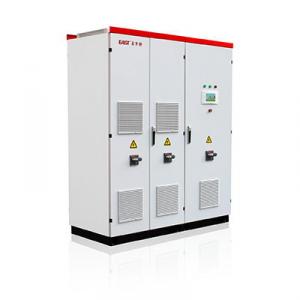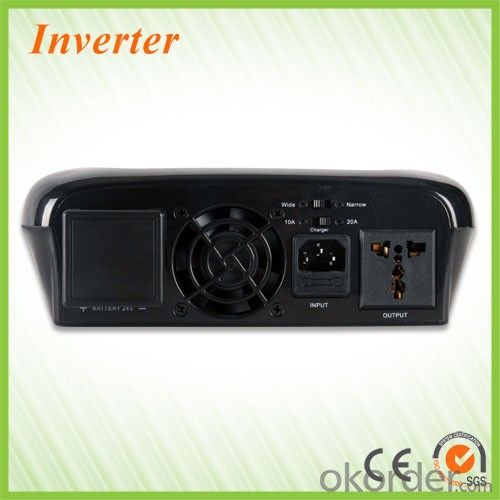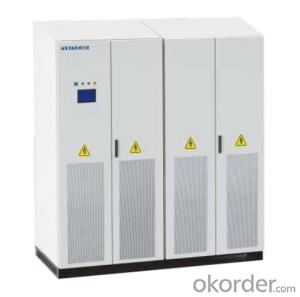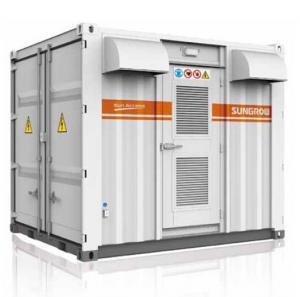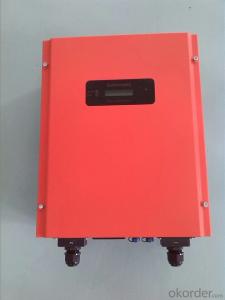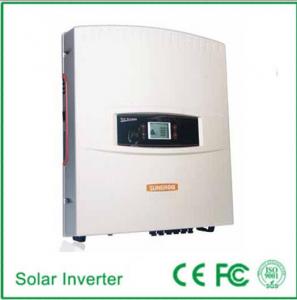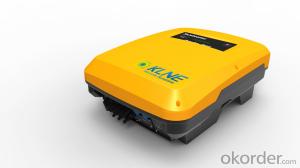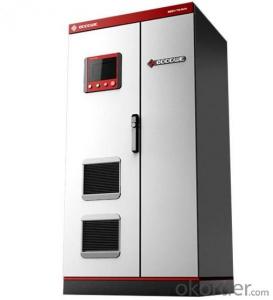Amazon Solar Inverter EA500KTL/H - Wider Input Voltage Range and Higher Efficiency On-Grid PV Central Inverter
- Loading Port:
- China main port
- Payment Terms:
- TT or LC
- Min Order Qty:
- 1 pc
- Supply Capability:
- 1000 pc/month
OKorder Service Pledge
OKorder Financial Service
You Might Also Like
EA500KTL/H
EA500KTF is designed with external isolation transformer. It has wider input voltage range and higher efficiency. Moreover, optical fiber isolation technology has been adopted to increase its anti-interference ability. Complete protection, higher MPPT efficiency, simple monitoring and capability of parallel operation make it ideal for large scale PV power plant.
● Maximum efficiency up to 98.7% (without transformer)
● Effective IGBT module
● Wide MPPT range, convenient for module configuration
● With DSP + CPLD digital control technology, having complete protection, safe and reliable
● Advanced MPPT (Maximum Power Point Tracking) algorithms
● Advanced Anti-islanding technology
● Efficient thermal system design, suitable for critical PV applications
● Multilingual LCD, easy to operate
● Integrated multi-communication interfaces, easy to monitor
● Low voltage ride through function
● For large centralized power plant connecting to high-voltage grid (with external step-up transformer)
● Active and reactive power regulation function (optional)
● TÜV CE, CQC certification
Specification / Type | EA500KTL | EA500KTH |
Input (DC) | ||
Max DC Voltage | 1000Vdc | |
Full-load MPPT Voltage Range | 450~820Vdc | |
Max DC Power | 550KWp | |
Max DC Current | 1200A | 1100A |
Number of DC Inputs | 16 | 16 |
Output (AC) | ||
Nominal AC Power | 500KW | |
Nominal AC Voltage | 270Vac | 350Vac |
AC Voltage Range | 210~310Vac | 245~362Vac |
Nominal Frequency | 50Hz/60Hz | |
Frequency Tolerance Range | 47-51.5Hz/57-61.5Hz | |
Distortion (THD%) | <3%(at nominal power) | |
Power Factor (Cos phi) | 0.9(leading)~0.9(lagging) | |
System Parameters | ||
Max Efficiency | 98.7% | |
Euro Efficiency | 98.5% | |
Protection Degree | IP20 (indoor) | |
Night Consumption | <100W | |
Operation Temperature Range | -25℃~+55℃ | |
Cooling | forced-air cooling | |
Relative Humidity | 0-95%, no condensation | |
Max Working Altitude | 2000m (derating above 3000m) | |
Display and Communication | ||
Display | LCD | |
Standard Communication | RS485 | |
Optional Communication | Ethernet /USB | |
Structure Parameters | ||
Dimensions(W×D×H) | 1800×800×2200mm | 1800×800×2200mm |
Weight | 1500kg | 1500kg |
· Q. What is an UPS and What it is for ?
An uninterruptible power supply (UPS) is a device that allows your computer or telephone switch or critical equipement to keep running for at least a short time or longer time when the primary power source is lost. It also provides protection from power surges, spikes, brownouts, interference and other unwanted problems on the supported equipment.
· Q. How long the UPS to run when power goes?
This can take 3 paths.
1.You can pick a UPS that is rated for pretty much the full VA you need so it will be running at 100% of capability and will thus last 'n' minutes.
2.You can pick a UPS that is rated at a much higher VA value than you really need so, for example, is running at 50% of capability and will thus last for longer than the UPS from option 1.
3.You can use extra external battery packs to run for longer. If charging capability allows, the more and the bigger batteries you take with, the longer time UPS runs.
or using a generator after about 6 hours, it will be more cost-effective, with a short runtime UPS to bridge the generator start-up gap.
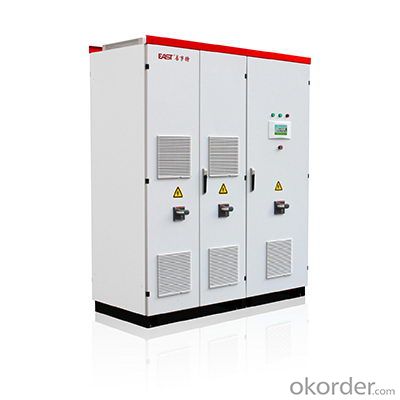

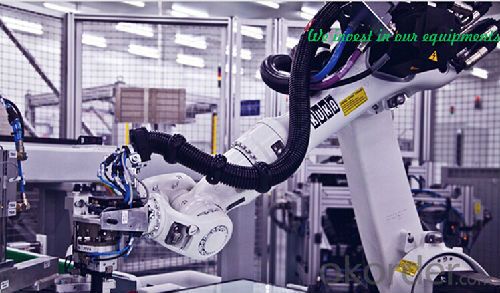
- Q: Is it possible to monitor the performance of a solar inverter remotely?
- Yes, it is possible to monitor the performance of a solar inverter remotely. Many modern solar inverters come with built-in data monitoring capabilities that allow users to track and analyze the system's performance from anywhere with an internet connection. Through web-based interfaces or smartphone applications, users can view real-time data, such as energy production, power output, and system status, as well as historical data and performance trends. Remote monitoring helps identify any issues or anomalies, optimize system performance, and ensure efficient operation of the solar inverter.
- Q: How does a solar inverter handle anti-islanding protection?
- A solar inverter handles anti-islanding protection by constantly monitoring the grid's voltage and frequency. If a disruption or loss of grid power is detected, the inverter immediately shuts down to prevent the solar energy from being fed back into the grid and potentially causing harm to utility workers or damaging the grid infrastructure. This safety mechanism ensures that the solar system is isolated from the grid during a power outage, allowing for a safe and efficient operation.
- Q: What is the typical installation process for a solar inverter?
- The typical installation process for a solar inverter involves several steps. Firstly, the location for the inverter needs to be determined, usually close to the solar panels and near the main electrical panel. The inverter is then mounted securely on a wall or other suitable surface. Next, the DC input wires from the solar panels are connected to the input terminals of the inverter. The AC output wires from the inverter are then connected to the main electrical panel. Finally, the inverter is connected to a monitoring system, if applicable, to track and manage the solar power generation. It is important to follow all safety guidelines and local electrical codes during the installation process.
- Q: Can a solar inverter be used with different grid voltages?
- No, a solar inverter cannot be used with different grid voltages. Solar inverters are designed to convert the DC power generated by solar panels into AC power that matches the specific voltage and frequency of the grid. Using a solar inverter with different grid voltages can cause damage to the inverter and can also be a safety hazard.
- Q: How does a solar inverter handle fluctuations in solar panel output due to temperature changes?
- A solar inverter handles fluctuations in solar panel output due to temperature changes by incorporating a maximum power point tracking (MPPT) algorithm. This algorithm continuously adjusts the voltage and current levels to optimize the power output from the solar panels, compensating for any temperature-related variations. By dynamically adapting to temperature changes, the solar inverter ensures that the maximum power is extracted from the panels and efficiently converted into usable electricity.
- Q: What is the maximum number of solar panels that a solar inverter can support?
- The maximum number of solar panels that a solar inverter can support depends on the specific model and its capacity. However, most solar inverters are designed to support a certain capacity or power rating, rather than a specific number of panels. The capacity of the solar inverter, measured in kilowatts (kW) or megawatts (MW), determines the maximum power output it can handle. The number of panels that can be connected to the inverter depends on the power rating of each panel. So, it is best to consult the manufacturer's specifications or seek professional advice to determine the maximum number of panels that can be supported by a specific solar inverter.
- Q: How does a solar inverter synchronize with the grid?
- A solar inverter synchronizes with the grid by constantly monitoring the grid's voltage and frequency. It adjusts its own output to match the grid's characteristics, ensuring that the electricity it generates is in phase with the grid's power supply. This synchronization process allows the solar inverter to seamlessly connect and feed electricity into the grid, maximizing the efficiency and reliability of the solar power system.
- Q: What is a solar inverter?
- A solar inverter is an electronic device that converts the direct current (DC) electricity generated by solar panels into alternating current (AC) electricity, which is suitable for use in homes, businesses, and the electrical grid.
- Q: What is the maximum efficiency rating of a solar inverter?
- The maximum efficiency rating of a solar inverter can vary depending on the specific model and technology used, but generally, the highest efficiency ratings can range from 95% to 99%.
- Q: How does a solar inverter handle partial shading on solar panels?
- A solar inverter handles partial shading on solar panels by employing a technology called Maximum Power Point Tracking (MPPT). MPPT allows the inverter to continuously monitor the voltage and current of each individual solar panel, and adjust the operating point of the panels to maximize power output. When shading occurs on one or more panels, the inverter adjusts the voltage and current of the unshaded panels to compensate for the reduced power output, ensuring the overall system performance is optimized.
Send your message to us
Amazon Solar Inverter EA500KTL/H - Wider Input Voltage Range and Higher Efficiency On-Grid PV Central Inverter
- Loading Port:
- China main port
- Payment Terms:
- TT or LC
- Min Order Qty:
- 1 pc
- Supply Capability:
- 1000 pc/month
OKorder Service Pledge
OKorder Financial Service
Similar products
Hot products
Hot Searches
Related keywords
